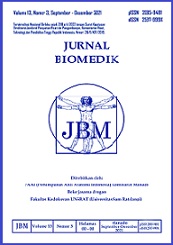PENATALAKSANAAN CAIRAN PERIOPERATIF PADA KASUS TRAUMA
DOI:
https://doi.org/10.35790/jbm.4.1.2012.743Abstract
Abstract: Trauma can be defined as a physical harm or damage to the structure or function of the body, caused by an acute exchange of mechanical, chemical, thermal, radioactive, or biological energy that exceeds the body’s tolerance. The commonly used resuscitation fluids are Ringer’s Lactate solution, normal saline, colloids, hypertonic saline, and blood products (packed red blood cells, fresh frozen plasma, or platelets). Fluid resuscitation strategy consists of early resuscitation and late resuscitation. The management of perioperative fluid therapy in traumatized cases requires a comprehensive understanding regarding the pathophysiology of shock, the consequences of fluid therapy in ongoing bleeding, and the ability to apply the evidence-based studies on each individual with different clinical status.
Key words: trauma, fluid resuscitation, shock
Â
Â
Abstrak: Trauma dapat didefinisikansebagai cedera atau kerusakan fisik dari struktur atau fungsi tubuh yang disebabkan oleh perubahan energi akut(mekanis, kimiawi, radioaktif, biologik) yang melampaui toleransi tubuh. Cairan resusitasi yang umunya digunakan pada kasus trauma ialah larutan Ringer laktat, NaCl fisiologis, koloid, NaCl hipertonik dan produk darah (packed red blood cells, plasma beku atau trombosit). Strategi resusitasi cairan terdiri dari resusitasi fase awal dan fase akhir. Penatalaksanaan terapi cairan perioperatif pada kasus trauma memerlukam pemahaman yang menyeluruh mengenai patofisiologi syok, efek terapi cairan pada saat perdarahan aktif, dan kemampuan untuk menerapkan bukti ilmiah pada masing-masing individu dengan keadaan klinis yang berbeda.
Kata kunci: trauma, resusitasi cairan, syok
Downloads
Issue
Section
License
Penyunting menerima sumbangan tulisan yang BELUM PERNAH diterbitkan dalam media lain. Naskah yang masuk dievaluasi dan disunting keseragaman format istilah dan cara penulisan sesuai dengan format penulisan yang terlampir dalam jurnal ini.
Segala isi dan permasalahan mengenai tulisan yang yang diterbitkan dalam jurnal menjadi tanggung jawab penuh dari penulis.







